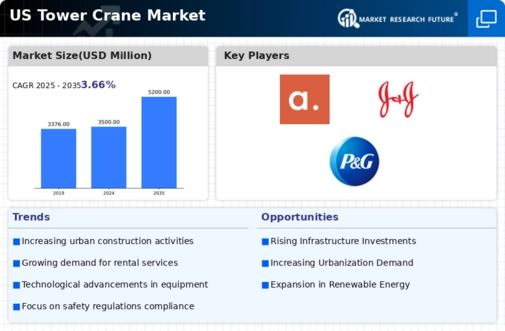Urban Redevelopment Projects
Urban redevelopment initiatives are playing a crucial role in shaping the tower crane market. As cities evolve and seek to optimize land use, the demand for tower cranes in urban settings is increasing. These projects often involve the construction of high-rise buildings and mixed-use developments, which require the capabilities of tower cranes to navigate limited space and lift heavy materials. The tower crane market is likely to benefit from this trend, as urban planners and developers recognize the efficiency and effectiveness of tower cranes in meeting the challenges of urban construction.
Rising Construction Activities
The tower crane market is experiencing a notable surge due to increasing construction activities across various sectors in the US. With a projected growth rate of approximately 5.5% annually, the demand for tower cranes is expected to rise significantly. This growth is driven by the need for efficient lifting solutions in large-scale projects, including commercial buildings, residential complexes, and infrastructure developments. As urban areas expand, the reliance on tower cranes for their ability to reach great heights and lift heavy materials becomes paramount. The tower crane market is thus positioned to benefit from this upward trend, as construction companies seek to enhance productivity and safety on job sites.
Government Infrastructure Investments
Government initiatives aimed at improving infrastructure are significantly impacting the tower crane market. With federal and state budgets allocating substantial funds for transportation, utilities, and public facilities, the demand for tower cranes is likely to increase. For instance, the US government has earmarked over $1 trillion for infrastructure projects, which will necessitate the use of tower cranes for construction and renovation. This influx of capital into the construction sector is expected to bolster the tower crane market, as contractors seek reliable equipment to meet project demands efficiently.
Increased Focus on Safety Regulations
The tower crane market is also influenced by the heightened emphasis on safety regulations within the construction industry. Stricter compliance requirements are prompting construction firms to invest in modern tower cranes equipped with advanced safety features. This trend is likely to drive the demand for new cranes that meet or exceed regulatory standards. The tower crane market is thus adapting to these changes, as companies prioritize worker safety and operational reliability. As a result, the market may witness a shift towards cranes that offer enhanced safety mechanisms, further stimulating growth.
Technological Innovations in Crane Design
Innovations in crane technology are reshaping the tower crane market. The introduction of advanced features such as automated controls, enhanced safety systems, and improved load management capabilities is driving demand. These technological advancements not only increase operational efficiency but also reduce the risk of accidents, which is a critical concern in the construction industry. The tower crane market is likely to see a shift towards smart cranes that integrate IoT technology, allowing for real-time monitoring and data analysis. This evolution in design and functionality is expected to attract more investments, further propelling market growth.














Leave a Comment